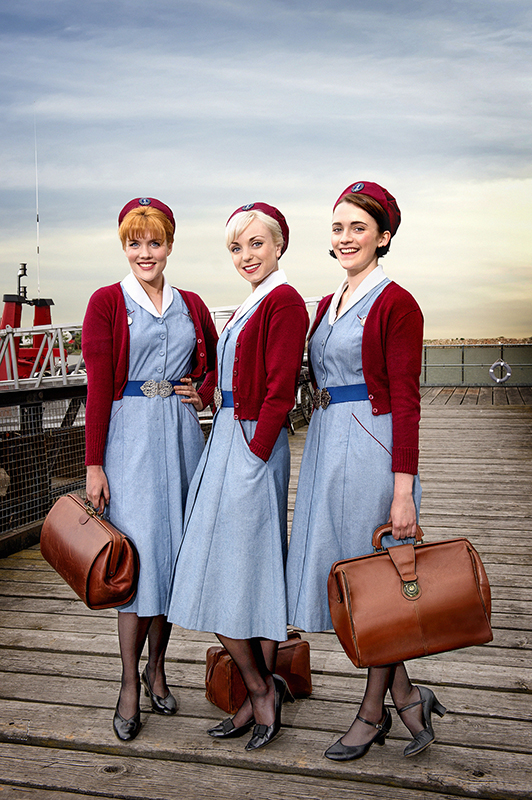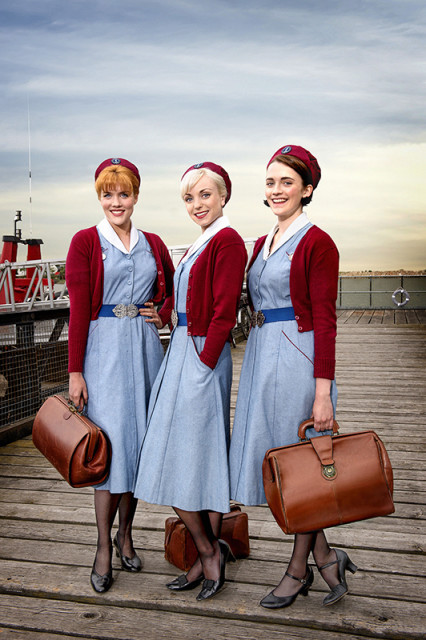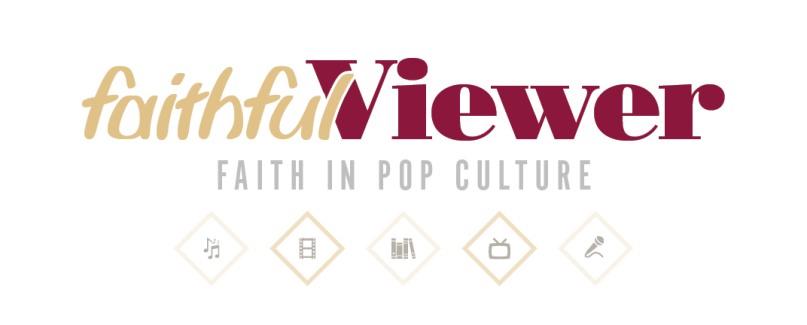
Patsy (Emerald Fennell), Trixie (Helen George) and Barbara (Charlotte Ritchie) in “Call the Midwife” on PBS. Photo courtesy of Red Productions Ltd 2015, via PBS
(RNS) I was thrilled to hear that PBS’ “Call the Midwife” has started a new season in the U.S., especially since a British friend had sworn to me that no more episodes were being produced. Back we can go to those breath-holding glimpses of transcendence, for the next eight Sunday nights. In the first new episode, the familiar voice of Vanessa Redgrave tells us that it is now 1961, when “science was all-powerful and all medicine was good.”
Through many small stories of births, this series tells a larger story about religion and health. The first two seasons were based on the memoirs of Jennifer Worth, one of the original nurse-midwives sent by the brand-new, publicly funded National Health Service to “Nonnatus House,” the fictional name for a real Anglican order of sisters who were also skilled midwives.
FAITHFUL VIEWER: Filmmaker crowdfunding documentary about ‘Same God’ flap
The most notable change from previous seasons seems to be that births are taking place in the clinic, not at home. Given the extreme poverty of the women in the neighborhood of Poplar, in the East End of London, “home” was often a crowded, dilapidated place, squeezed in between mountains of bombed-out rubble still left from the war.
Worth (the real “Jenny”), who sadly died just before the first season aired, portrays a Poplar that is much more intractably tragic than the nevertheless serious stories the show offers.
What the program shows us is how the NHS, the most socialized of Western medical systems — planned during the war and created just afterward — partnered with a religious organization to deliver high-quality care to those most in need. The sisters of Nonnatus House had been delivering babies in the dockworkers’ homes since the 19th century and already knew the neighborhood, the pubs, the police, the criminals, the language and the culture.
When in the first season we saw the fictional Jenny often recoiling from the living conditions, the accompanying sister would urge her, not unkindly, to “get on with it.” The sisters, having taken a vow of poverty themselves, served this community, as insiders, throughout their long lives. They had a calling.
It is the reigning paradigm in public health today that social factors — income and wealth inequality, racism, injustice and unequal access to education and housing — are the primary determinants of the health of populations, not simply their medical care. The World Health Organization’s 2007 Commission on the Social Determinants of Health defined the social determinants as “the circumstances in which people are born, grow up, live, work, and age, and the systems put in place to deal with illness. These circumstances are in turn shaped by a wider set of forces: economics, social policies, and politics.”
There was a strong ethical impetus to the commission members’ work; one can sense the outrage on the first page when they write: “Our children have dramatically different life chances depending on where they were born.” In Japan or Sweden they can expect to live more than 80 years; in several African countries, life expectancy can be under 50 years. “It is not right that it should be like this,” the report says.
Yet, despite their emphasis, religion — as a set of beliefs and practices, as a prominent institution in communities, as a provider of medical care in countries around the world — does not appear anywhere in the report.
This is the stunning oversight that a group of faculty members at Emory University sought to address in our book, “Religion as a Social Determinant of Public Health.” From the perspectives of public health, theology, religious studies, sociology, anthropology, ethics, law, nursing and medicine, we argued that religion is also a social circumstance that determines health — for both good and sometimes, undoubtedly, for ill — and it cannot be treated as if it were invisible.
Religion’s relationship to health is clearly complicated. It is easy to think of religiously motivated conflict and strife around the world that has a devastating effect on health, perhaps especially the health of vulnerable mothers and children. At the same time, there is a considerable amount of research showing that higher levels of religious participation in Western countries are associated with lower rates of mortality. People who attend religious services tend to have lower rates of risky behavior such as smoking and excessive drug and alcohol use, and higher rates of protective factors like marriage.
Health researchers would call these mechanisms social support and social control. But there is a third link, exemplified by “Call the Midwife” — the social capital a religious institution holds in its community. The Anglican sisters of Nonnatus House offer us a real example of a religion-public health partnership that extended expert, compassionate and low-cost care (remember, half of the midwives were working without pay) to some of the neediest, most socially determined women in London.
As an American mother of two children delivered by a certified nurse midwife, I certainly applaud the education and positive image the show offers us about nurse-midwifery. In the United States, just 8 percent of infants are delivered by midwives; women without health insurance and those on Medicaid — our own neediest mothers — are much more likely than women with private health insurance to be receiving prenatal care from CNMs.
But even more, I applaud the dual “calling” depicted in “Call the Midwife” — of the common purpose and cooperative partnership of the nascent National Health Service with the sisters of Nonnatus House. In today’s very secular Great Britain, the NHS is said to be “the closest thing we have to a religion.” Ironically, for one corner of London, that is how it got its start.
(Ellen Idler is Samuel Candler Dobbs Professor of Sociology at Emory University and editor of “Religion as a Social Determinant of Public Health”)






